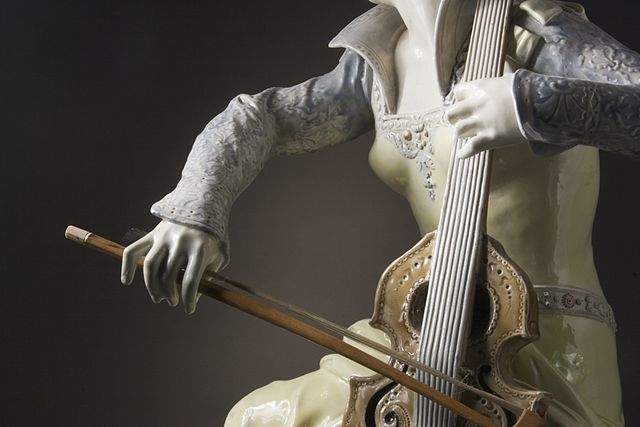
“I was never less alone than when by myself,” wrote English historian Edward Gibbon. In their developing years, musicians spend countless hours alone in practice, save for the company of their instruments. It is no wonder that there is an abundance of literature for unaccompanied instruments. Join us this hour on Harmonia, as we’re “going solo.”
We heard the overture from Charles Dieupart’s Harpsichord Suite No. 3 in G Minor.
The Lonely Keyboardist
Keyboard instruments like the harpsichord, organ, and piano are used for both solo and ensemble playing. Due to their ability to play many notes at once, these instruments are especially well suited to unaccompanied literature. Who needs another player when you can play all the harmonies by yourself? We’ll begin our solo journey with harpsichord music by Charles Dieupart. Dieupart’s best known work is his collection Six Suittes de Clavecin, published in 1701. The suites became so popular that they were reissued a year later in chamber music form — for recorder or violin, and basso continuo. I guess it goes to show, you can’t keep such a good thing to yourself!
We heard harpsichordist Fernando Miguel Jaloto performing the allemande, passepied, and gigue from Suite No. 2 in D Major by Charles Dieupart.
Like the harpsichord, the organ has a rich history of solo literature. Perhaps the oldest surviving music for organ is the Robertsbridge Codex from mid-14th-century England. The source includes estampies and three motets written in Ars Nova style.
Music from the Robertsbridge Codex and another contemporary English source. That was performed by organist Daniel Beilschmidt on the 2017 Genuin release Fortuna Desperata.
Virtuoso Violinists
There’s a LOT of solo repertoire out there for the violin, and it cuts across classical, popular, and folk genres. Some of the earliest music for solo violin was written by Heinrich Biber. Charles Burney, the noted explorer and music historian, wrote, “Of all the violin players in the last century, Biber seems to have been the best, and his solos are the most difficult and the most fanciful of any Music I have ever seen of the same period.”
Beginning with a descending minor scale, known as a lament bass, this Passacaglia from Biber’s “Mystery Sonatas” creates the effect of a solo violin playing over a bass line, even though there’s really only one instrument playing. Let’s hear that passacaglia now.
We heard Heinrich Biber’s Passacaglia in G Minor. We can compare Biber’s passacaglia to Bach’s solo violin partitas, even though the latter was not written until nearly half a century later. Despite their popularity today, Bach’s partitas fell out of fashion and were not often heard in the years after his death, until Joseph Joachim, famed for his connection to Brahms, took them up in the late 19th century.
We heard Ingrid Matthews, performing the Preludio from J. S. Bach’s Violin Partita No. 3 in E Major.
One-Man Band
Sometimes, a soloist will play the parts of several musicians. A singer might accompany himself on the guitar, harpsichord, vielle, or, in this case, the plectrum lute.
On the recording Kingdom of Heaven, Ensemble Dragma explores music written for one-man band. The ensemble reconstructs devotional poems by 15th-century German poet Heinrich Laufenberg, transforming them into songs, using contemporary melodies, with instrumental accompaniment.
We’ll hear a song which details a conversation between a teacher and his pupil about the ten commandments. In this poem, the teacher tries to convince his student to choose to spend his time working and following the commandments, rather than “springing, dancing, and being merry.”
A reconstruction of a poem by Heinrich Laufenberg — from a recording called Kingdom of Heaven, by Ensemble Dragma.
Firminus Caron: Twilight of the Middle Ages
On our featured release, the 2016 recording Firminus Caron: Twilight of the Middle Ages, the Huelgas Ensemble explores music of Franco-Flemish polyphonist Firminus Caron. Though not exactly a household name, Caron must have been pretty popular in his day. Tinctoris considered him to be an excellent composer, ranking him with Ockeghem and Busnoys. Five of Caron’s masses survive. Let’s hear the Sanctus from the Missa Clemens et Benigna.
We heard the Sanctus from the Missa Clemens et Benigna. Music by by Firminus Caron, performed by Huelgas Ensemble.
Despite the popularity of his sweet and beautiful melodies, the details of Caron’s life remain elusive. His works, mainly mass settings and secular chanson, span a two decade career from approximately 1455 to 1475. We’ll close out the hour with a chanson by Firminus Caron.
A secular chanson by Firminus Caron, performed by Huelgas Ensemble, and directed by Paul van Nevel.
Break and theme music
:30, Kingdom of Heaven, Ensemble Dragma, Ramee 2014, Tr. 2 Anonymous: Myn trud gheselle
:60, Fortuna Desperata, Daniel Beilschmidt, Genuin 2017, Tr. 7 Ileborgh: Preambulum super d a f et g
:30, Firminus Caron, Hueglas Ensemble, Sony 2016, Tr. 1 Kyrie L’homme armè
Theme: Danse Royale, Ensemble Alcatraz, Elektra Nonesuch 79240-2 1992 B000005J0B, Tr. 12 La Prime Estampie Royal
The writer for this edition of Harmonia was Sarah Huebsch.
Learn more about recent early music CDs on the Harmonia Early Music Podcast. You can subscribe on iTunes or at http://www.harmoniaearlymusic.org.









